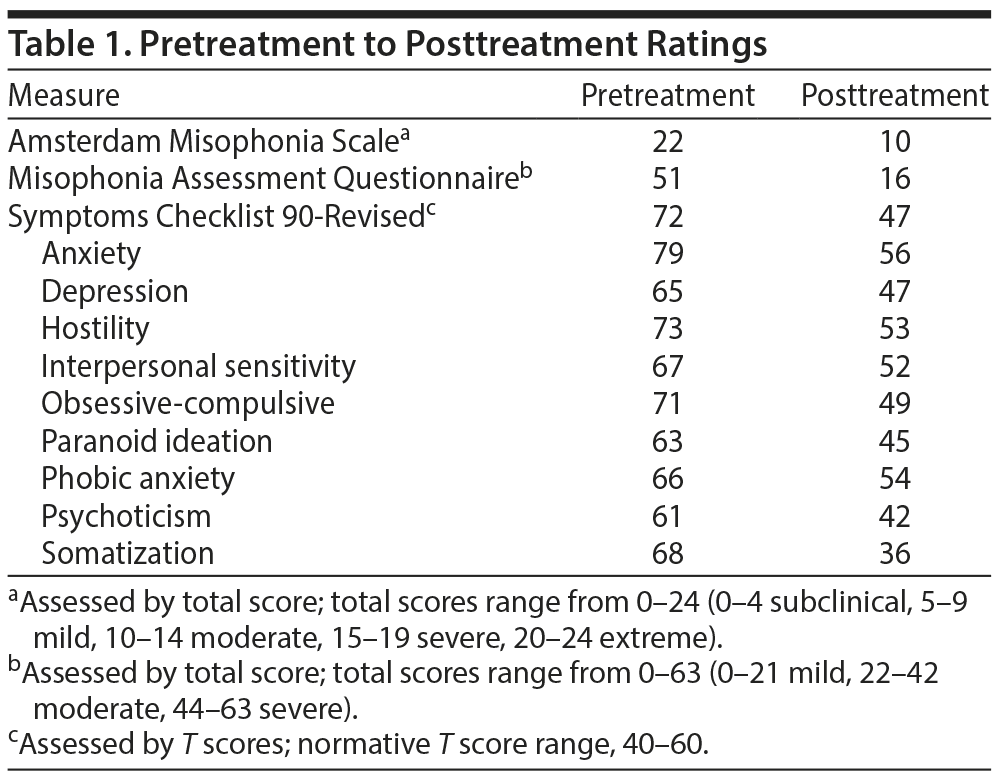Because this piece does not have an abstract, we have provided for your benefit the first 3 sentences of the full text.
To the Editor: Misophonia, characterized by increased sensitivity to sound, results in intense emotional and behavioral responses to triggering auditory stimuli. Observed to share symptoms with anxiety and obsessive-compulsive spectrum disorders, misophonic symptoms are acknowledged as a separate, underrecognized condition. Recommendations for diagnostic classification have been identified, with variability in the emotional response to auditory sensitivity theorized (ie, distinction between those experiencing anxiety/distress and those experiencing anger/rage).
Using Dialectical Behavior Therapy to Treat Misophonia in Adolescence
To the Editor: Misophonia, characterized by increased sensitivity to sound, results in intense emotional and behavioral responses to triggering auditory stimuli.1,2 Observed to share symptoms with anxiety and obsessive-compulsive spectrum disorders, misophonic symptoms are acknowledged as a separate, underrecognized condition.3 Recommendations for diagnostic classification have been identified,1 with variability in the emotional response to auditory sensitivity theorized (ie, distinction between those experiencing anxiety/distress and those experiencing anger/rage).4 Case studies5-7 have demonstrated success at reducing misophonic symptoms using cognitive-behavioral therapy (CBT) and exposure. It has been theorized that while CBT shows promise with those experiencing the distress response,4,8 dialectical behavior therapy (DBT) may be more appropriate for those experiencing intense rage responses,4,9 as it focuses on acceptance of one’s anger rather than reducing it through exposure. DBT may be especially salient for individuals who do not respond to CBT and those for whom exposure only intensifies anger.9 Despite strong theoretical support,4,9 there is no empirical support for the use of DBT to treat misophonia in adolescents.
Case report. Jenny,* a 16-year-old white adolescent girl with comorbid diagnoses of misophonia (per the diagnostic criteria proposed by Schröder and colleagues1) and social anxiety (DSM-5 criteria), endorsed numerous misophonic symptoms: self-reported rage associated with sounds of chewing and sniffling, significant guilt associated with her rage, isolation from family and friends, avoidance of situations with triggering sounds (eg, during exams, meals with friends and family), and physiologic anger responses (eg, increased heart rate and body temperature, muscle tension, tearfulness). Jenny had a history of outpatient CBT treatment (beginning October 2015) for 6 months prior to the present treatment, involving exposure to triggering sounds to reduce anger. Jenny reported the CBT with exposure treatment did not extinguish her anger; rather, it intensified her experience of rage. She endorsed feelings of hopelessness regarding her misophonic symptoms.
Jenny received DBT via a partial hospitalization treatment milieu she attended 5 days a week for 7 weeks (beginning April 2016).10 Individual DBT sessions, occurring once per week, focused on altering her relationship to her anger. Jenny responded to orientation to the biosocial theory11 and understanding her ability to transact differently with her environment despite her biological predisposition to anger. Jenny’s treatment concentrated heavily on learning to be mindful of her rage and tolerate this emotion through acquisition of acceptance-based DBT skills (ie, mindfulness and distress tolerance skills). These acceptance-based skills provided opportunity for change strategies focused on alternative responses to anger by regulating her guilt and reducing engagement in behavioral urges (ie, to avoid and become verbally and physically aggressive). Medication was managed by the program psychiatrist (paroxetine hydrochloride 25.0 mg) to simultaneously manage misophonic and anxiety symptoms.
Jenny completed the Amsterdam Misophonia Scale,1 Misophonia Assessment Questionnaire,12 and Symptoms Checklist 90-Revised13 at the start of treatment and at discharge (Table 1). Misophonic symptoms reduced from extreme to moderate (Amsterdam Misophonia Scale) and severe to mild (Misophonia Assessment Questionnaire). Severity of global psychological symptoms reduced from clinically significant elevation to within the normative range; this trend was observed on subscales commensurate with misophonic symptoms (anxiety, hostility, obsessive-compulsive, somatization).
Disparate emotional responses to misophonic symptoms suggest that a singular therapeutic approach may not be appropriate for all cases.4 Although CBT to treat misophonia in adolescence has demonstrated promise,5-7 the present case report suggests that DBT may also be a promising approach and highlights the importance of diagnostic precision in treatment. Conceptualizing the patient’s emotional response to her misophonic symptoms as anger/rage directed the choice of skills to focus on in treatment (ie, acceptance vs change based). Additional research, particularly larger-scale studies controlling for confounding treatment factors such as level of care (ie, partial hospitalization vs outpatient), is needed to empirically support DBT as a treatment for misophonia.
References
1. Schröder A, Vulink N, Denys D. Misophonia: diagnostic criteria for a new psychiatric disorder. PLoS One. 2013;8(1):e54706. PubMed doi:10.1371/journal.pone.0054706
2. Wu MS, Lewin AB, Murphy TK, et al. Misophonia: incidence, phenomenology, and clinical correlates in an undergraduate student sample. J Clin Psychol. 2014;70(10):994-1007. PubMed doi:10.1002/jclp.22098
3. Bruxner G. ‘ Mastication rage’ : a review of misophonia: an under-recognized symptom of psychiatric relevance? Australas Psychiatry. 2016;24(2):195-197. PubMed doi:10.1177/1039856215613010
4. Webber TA, Storch EA. Toward a theoretical model of misophonia. Gen Hosp Psychiatry. 2015;37(4):369-370. PubMed doi:10.1016/j.genhosppsych.2015.03.019
5. Bernstein RE, Angell KL, Dehle CM. A brief course of cognitive-behavioral therapy for the treatment of misophonia: a case example. Cogn Behav Ther. 2013;6:1-13.
6. McGuire JF, Wu MS, Storch EA. Cognitive-behavioral therapy for 2 youths with misophonia. J Clin Psychiatry. 2015;76(5):573-574. PubMed doi:10.4088/JCP.14cr09343
7. Reid AM, Guzick AG, Gernand A, et al. Intensive cognitive-behavioral therapy for comorbid misophonic and obsessive-compulsive symptoms: a systematic case study. J Obsessive Compuls Relat Disord. 2016;10:1-9. doi:10.1016/j.jocrd.2016.04.009
8. Webber TA, Johnson PL, Storch EA. Pediatric misophonia with comorbid obsessive-compulsive spectrum disorders. Gen Hosp Psychiatry. 2014;36(2):231.e1-231.e2. PubMed doi:10.1016/j.genhosppsych.2013.10.018
9. Schneider RL, Arch JJ. Letter to the editor: potential treatment targets for misophonia. Gen Hosp Psychiatry. 2015;37(4):370-371. PubMed doi:10.1016/j.genhosppsych.2015.03.020
10. Del Conte G, Lenz AS, Hollenbaugh KM. A pilot evaluation of dialectical behavior therapy for adolescents within a partial hospitalization treatment milieu. J Child and Adolescent Counseling. 2016;2:16-32. doi:10.1080/23727810.2015.1134008
11. Linehan MM. Cognitive-Behavioral Treatment of Borderline Personality Disorder. New York, NY: Guilford Press; 1993.
12. Johnson M. 50 Cases of Misophonia Using the MMP. Atlanta, GA: Misophonia Conference of the Tinnitus Practitioners Association; 2014.
13. Derogatis LR, Lipman RS, Covi L. SCL-90: an outpatient psychiatric rating scale-preliminary report. Psychopharmacol Bull. 1973;9(1):13-28. PubMed
14. Dozier TH. Counterconditioning treatment for misophonia. Clin Case Stud. 2015;14:374-387. doi:10.1177/1534650114566924
aYale University Child Study Center, New Haven, Connecticut
bDepartment of Psychology, The University of Memphis, Memphis, Tennessee
cDaybreak Treatment Center, Germantown, Tennessee
Potential conflicts of interest: None.
Funding/support: None.
Disclaimer: Ms Kamody served as primary therapist, under clinical supervision of co-author Dr Del Conte. Dr Del Conte is a DBT-Linehan-board certified clinician.
Patient consent: Consent was obtained from the patient and her legal guardian to publish the case report, and information was de-identified to protect anonymity.
Published online: September 14, 2017.
Prim Care Companion CNS Disord 2017;19(5):17l02105
https://doi.org/10.4088/PCC.17l02105
© Copyright 2017 Physicians Postgraduate Press, Inc.
*Pseudonym.
Please sign in or purchase this PDF for $40.00.
Save
Cite


